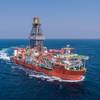Feature:SEMCO Builds World's Largest Liftboat
By Larry Pearson
Lift boats are the unglamorous vessels of oil and gas well servicing industry. They travel to the job site with three large cylindrical legs rising 150-250 ft. above the waterline. Once onsite, lift boats lower their legs to the seabed and raise their hull up to 100 ft. above the waterline to be even with the structure they are servicing to provide a stable platform for workers to transit from the lift boat to the project in which they are working.
These versatile vessels can serve through the entire life of a oil or gas well from driving casing to provide a "path" for a jackup rig to drill through construction of the platform, repair and renovation of the platform to plug and abandonment of the well.
Lift boats typically mount 2-3 cranes to assist the construction and/or repair of the well. These vessels also provide accommodations for the workers and the platform also hauls construction equipment, tools and material to the wellhead.
The above summarizes some of the main features of the Dixie Patriot, a new super capacity lift boat built by SEMCO, LLC, Lafitte, La. "This is the world's largest lift boat, anyway you measure it from leg length, total HP or size of work platform, said George Marcal, shipyard representative for SEMCO LLC. "We see a near term need for such a vessel with the increased activity drilling for "deep gas in shallow water," explained Marcal.
There is little doubt that activity on the shelf drilling for deep gas is on the increase. The U.S. Interior Department, through the Minerals Management Service (MMS) is offering royalty relief for those companies who drill below 15,000 ft. on existing leases for natural gas. Prior to this program there has been no incentive for drilling companies to invest the millions of dollars necessary to explore for gas on leases where they have drilled before. There is even a provision for royalty relief if dry holes are drilled.
Improved 3-D and 4-D imaging has shown large deposits of gas below the 15,000- ft. mark and the MMS is easing royalty payments to encourage this drilling.
The Dixie Patriot, completed at SEMCO's shipyard in Lafitte, La. in mid-August is the newest, high capacity lift boat in the Gulf of Mexico (GOM). The vessel is 176.5 ft. by 113- ft. wide with a 13- ft. deep hull. Three huge legs, 280 ft. long and 8.5 ft. wide can be lowered up to 200 ft. in the water. In shallower waters, (100 ft.) the hull can be lifted (or "jacked up") 100 ft. above the waterline to work on tall platforms.
The vessel is propelled by a pair of 1,500 hp Caterpillar 3512 engines driving Twin Disc gears and spinning Kaplan stainless steel 79-in. diameter props. Many lift boats use PTOs off the main engines to drive the hydraulic pumps that raise and lower the lift boat hull on the three legs.
The Dixie Patriot utilizes a pair of Caterpillar 831 hp 3412 DITA engines that drive six jacking pumps that power the hydraulic motors located in each leg. These motors power the motion of the 280- ft. long legs. Controls for the propulsion engines and the hydraulic lift controls is by Engine Monitor, Inc., St. Rose, La. The vessel uses 5,000 gallons of hydraulic fluid in a tank that is first filtered through Parker suction filters before it enters the Hydrokraft hydraulic pumps driven by the Caterpillar 3412 DITA engines. The high pressure hydraulic oil is then fed to the hydraulic motors on the jacking legs. The oil is then returned to the tank after first being filtered through Parker return oil filters. This closed loop system insures the optimum power is being applied to the legs under all operating conditions.
The engine room also contains a pair of Caterpillar 3412 engines each producing 425 kW of electric power. Some of the electricity is used to power a 500 hp SMI bow thruster.
An emergency generator is housed in an enclosure on the 03 level. A Caterpillar 3306 genset provides 190 kW of emergency power per ABS guidelines.
Engine cooling for the propulsion engines is via box coolers. The jacking engines and the generators utilize remote radiators for water cooling.
The hull actually has two engine rooms separated by a room dominated by huge banks of hydraulic filters. Each engine room has a propulsion engine. The starboard engine room has the two jacking engines and pump sets while the port engine room holds the two gensets. Each engine room contains a pair of remote radiators for the jacking and generator engines plus pumps, electrical switchgear and other mechanical equipment.
The hull also contains many tanks holding essential liquids for the people and equipment on the vessel. For example, to feed those thirsty six diesel engines, the vessel has fuel storage of 28,000 gallons plus a day tank of 15,000 gallons. Potable water is contained in a pair of 15,000-gallon tanks. The aforementioned hydraulic oil tanks holds 5,000 gallons and the lube oil and waster oil tanks hold 1,000 gallons and 2,000 gallons respectively.
Considerable tankage is set aside for oily bilge water with space for 40,000 gallons.
The main work deck of the Dixie Patriot is 11,000 sq. ft. with a deck loading of one million pounds. "The vessel has the space and strength to hold almost anything a construction crew would take to sea," Marcal said.
The outstanding feature of the main deck is the two cranes that are installed around the two jacking legs at the bow. Each crane can lift 200 tons and have a reach of 140 ft. When the cranes are not deployed they lie on supports on each side of the super structure "pointing" at the heliport that can land a Bell 212 copter or equal. The main deck superstructure of the Dixie Patriot is mainly filled with the galley; a dry storage and pantry area, a laundry area and a dining are that can seat 36 persons at four long tables with fixed seating. On the 01 deck is accommodation for 20 people in five, four person rooms plus a lounge, head with showers plus a linen closet. The 02 deck is very similar to the 01 deck, also with accommodations space for 20 persons. Construction workers typically occupy these two decks.
The 03 level provides accommodations for the crew with a single room for the captain, a two person VIP room, a three-person and a four-person space. Each of these spaces has a head, shower and lockers for personal effects storage. The 03 level also has a large recreation room and a ship's office. Each of the accommodation levels has an air handler complete with cooling and heating coils. The air handler circulates warm or cool air, depending on the thermostat setting, to the level on which it is located. The air conditioning condensing units for the separate air handlers are located on the 04 deck outside of the pilothouse.
The pilothouse of the Dixie Patriot is on the 04 level. The pilothouse is equipped with electro/hydraulic steering with both follow up and non-follow up modes. "We manufactured and supplied the steering controls plus the lift controls for the legs and the propulsion controls for the Dixie Patriot," said Jack Rowley, general manager of EMI. The bridge of the vessel has a complete GMDSS communications system and navigation by JRC and supplied by Frank L. Beier Radio of New Orleans. The communications equipment includes a VHF/FM Radio Telephone set, a JSS-800 medium/high frequency radio set including a DSC Watch Receiver and a JRC Inmarsat C voice/data satellite system. On the navigation side, there is a JRC Navtex Receiver, JRC GPS, a JRC radar and a CMZ gyro compass system. A Furuno depth sounder rounds out the pilothouse equipment. Each crane is equipped with a VHF Eclipse VHF radio.
The Dixie Patriot is the third lift boat built recently by SEMCO LLC. In 1991, the Dixie Legacy with 250-foot legs was delivered and in 2002 the slightly larger Dixie Endeavor with 265-foot legs was built. "Both of those vessels were later sold to Superior Energy Corporation," said Dan Dickson, project manager for SEMCO. "We will be starting another lift boat with 280-foot legs later this year," Dickson said, and we are looking at designs for a 300-foot plus lift boat as the natural progression of lift boats with longer and longer legs continues," Dickson said.










